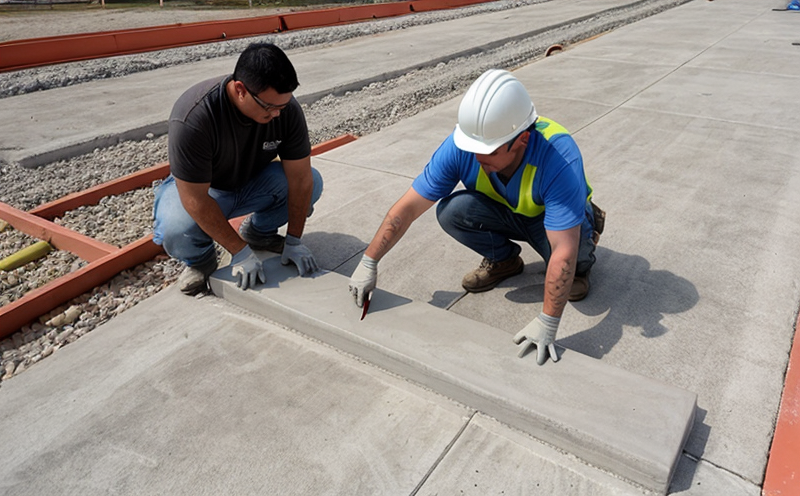Precast concrete element inspection
The construction and building sector relies heavily on precast concrete elements as a critical component of modern infrastructure. These components are fabricated off-site in factories under controlled conditions, ensuring consistency and quality that may not be achievable on site. Precast concrete element inspection is crucial to ensure the structural integrity, durability, and safety of buildings and structures.
Precast concrete elements can include beams, columns, slabs, foundations, and other components used in both residential and commercial projects. The inspection process involves a series of non-destructive tests (NDT) and destructive testing methods to evaluate the quality of these components before they are installed on-site. This ensures that any defects or inconsistencies are identified early, preventing costly rework and delays.
The inspection typically includes visual inspections, dimensional checks, and material evaluation using ultrasonic testing, infrared thermography, X-ray radiography, and other advanced techniques. These methods allow inspectors to assess the concrete’s density, homogeneity, and internal structure without damaging the element itself.
For quality control purposes, laboratories often perform destructive tests such as bending or compression tests on samples taken from precast elements. This helps to verify that the components meet specific design standards and codes. International standards like ISO 17862:2015 and ASTM C469-13 provide guidelines for these procedures.
The inspection process also involves compliance checks against local building regulations, such as those outlined in the Building Code of Australia (BCA) or the American Society of Civil Engineers (ASCE). These codes ensure that all precast concrete elements are suitable for their intended use and contribute to a safe and sustainable built environment.
By implementing rigorous inspection protocols, construction firms can minimize risks associated with substandard materials and improve overall project performance. This leads to more reliable structures capable of enduring environmental challenges over time. Moreover, compliance with regulatory standards enhances the reputation of builders and contractors in competitive markets.
Benefits
- Enhanced Structural Integrity: Thorough inspection ensures that all precast concrete elements meet stringent quality criteria, reducing the likelihood of structural failures.
- Cost Efficiency: Early detection of defects through comprehensive inspections prevents costly repairs and rework later in the project lifecycle.
- Regulatory Compliance: Adherence to industry standards guarantees that all components comply with applicable regulations, thereby avoiding legal issues and penalties.
- Improved Safety: Ensuring the quality of precast concrete elements contributes significantly to occupant safety by minimizing potential hazards in buildings.
Quality and Reliability Assurance
The process of inspecting precast concrete elements is essential for maintaining high standards within the construction industry. Quality assurance (QA) programs play a pivotal role in ensuring that all inspection activities are conducted consistently and effectively.
Laboratories involved in this service employ experienced technicians who use cutting-edge technology to conduct detailed analyses. Regular training sessions keep staff updated on new methods and best practices, further enhancing their capabilities. Compliance with international standards such as ISO 17862:2015 ensures that all inspections adhere to recognized benchmarks.
Advanced instrumentation used during these inspections includes ultrasonic testing equipment for measuring concrete thickness and density, infrared cameras for detecting surface temperature variations indicative of internal flaws, and X-ray machines capable of generating detailed images of the element’s interior. These tools provide precise data that can be analyzed to identify potential weaknesses or inconsistencies.
Once inspections are completed, detailed reports are generated outlining findings along with recommendations for any necessary corrective actions. This documentation serves as a valuable resource for project stakeholders, enabling informed decision-making throughout the construction process. It also facilitates tracking of quality performance over time, contributing to continuous improvement efforts within organizations.
In summary, robust QA measures supported by sophisticated inspection techniques are crucial in delivering reliable precast concrete elements that meet or exceed expectations set forth by relevant codes and standards.
Customer Impact and Satisfaction
The impact of effective precast concrete element inspection extends beyond mere compliance with regulations; it significantly enhances customer satisfaction levels. When construction projects deliver high-quality, reliable components, end-users benefit from safer buildings that are more durable and energy-efficient.
For quality managers and compliance officers involved in specifying materials for new developments or renovation projects, knowing that every component has undergone rigorous testing provides peace of mind. This trust translates into better relationships with clients who appreciate the attention to detail shown by contractors and suppliers.
R&D engineers responsible for developing innovative solutions find value in reliable data obtained from inspections as it informs future product improvements. Procurement professionals can leverage this information when sourcing materials, ensuring they select suppliers committed to excellence.
Ultimately, satisfied customers lead to repeat business opportunities and positive word-of-mouth referrals which are vital assets for any organization operating within the construction sector. By prioritizing quality through comprehensive inspection processes, companies not only meet but surpass customer expectations while fostering long-term success.





